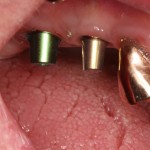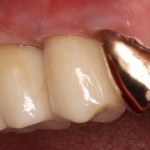Implant Dentistry Case Presentation
The current implant dentistry case, shows the issue of newer restorations next to older restorations.
A patient of record presented with a unrestored #4 (premolar) implant. The dental implant was fully integrated and was ready for restorative treatment. Clinically, I noted that #3 (molar) had a isolated 8 mm probing depth on the palatal root. A x-ray was taken of the area with a gutta percha tip, and a radiolucent area was noted. Surgical examination revealed a vertical root fracture and the tooth was extracted with a bone graft preservation. Approximately 4 months post operatively, a Straumann 4.8mm WN was placed in parallel with #4 implant. The patient was referred to her general dentist for zirconia porcelain implant restorations. When I saw the patient again, I asked “what she thought of her new teeth?” She replied “why are they not gold?” I had no response.
- Unrestored Dental Implants
- Porcelain Zirconia Implant Restorations
Implant Dentistry Treatment Planning
Proper treatment planning is the most crucial determining factor for achieving success in implant dentistry. Majority of complications can be avoided by systematic recording of a pre-operative medical history and a meticulous clinical and radiographic examination leading to a defined treatment plan. Treatment planning for patients that present with hopeless or missing teeth due to cavities or periodontal disease, typically require some type of socket bone preservation or additional bone graft for proper dental implant placement. The therapeutic goals of comfort, function, and predictability are desirable and achievable with implant-supported restorations. High success rates have been attained in both fully edentulous and partially edentulous situations. Bone grafting techniques are required in many treatment plans due to variable degrees of bone resorption and remodeling following tooth loss. Numerous studies ahve documented significant dimensional changes in both height and width of the alveolus following tooth loss. Approximately two-thirds of these changes were found to occur in the first few months of post extraction healing. Procedures aimed at socket preservation are performed performed in order to conserve bone volume and thus maintain the soft tissue position.





 by
by 


